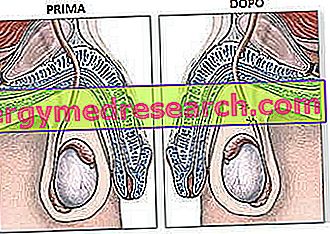Generality
The swollen lips are generally due to an accumulation of liquids inside them, in the spaces between the tissue cells and the blood capillaries.
Labial edema

Causes of swollen lips
EDEMA FORMATION MECHANISM
In most cases, localized edema occurs due to an ongoing inflammatory process. If the tissues of the lips are struck by an inflammatory stimulus (the sting of an insect, contact with an allergen, a burn, etc.), they react with a series of modifications aimed at circumscribing the damage and repairing it. To this end, it is essential to send the cells and substances necessary to support the immune and reparative processes into the area; we will therefore have an increase in blood flow and capillary permeability. In practice, the tiny blood vessels of the lips are more easily traversed by immune cells and plasma (liquid part of the blood); a material is thus accumulated (called exudate) which determines the swelling of the lips.
POSSIBLE CAUSES OF GONFIE LIPS
- Allergic reactions : swelling of the lips is a common sign of many allergies. In sensitizing people, contact with very small amounts of allergens is enough to trigger, within a few minutes, the typical symptoms of an allergic reaction, including the labial edema.
Suffice it to say that in the clinical setting an examination called " challenge labial " can be used to understand whether a person is allergic or not to a food; for this purpose the food is rubbed directly on the lips or a drop of the blended food is placed on them in an aqueous solution. The subject considers himself allergic if, within 15 minutes of contact with the food, he develops erythema (redness) and / or labial edema, perioral urticaria (around the mouth) or symptoms of a generalized allergic reaction. The allergic subject, on the other hand, will experience a sense of tension, itching or numbness in the lips.
One of the most common causes of allergic reactions is the contact with:
- foods: those most commonly implicated in allergic reactions are nuts, crustaceans and molluscs, eggs, sesame seeds, soy;
- cosmetics: such as lipsticks and lip sticks
- animal hair
- animal bites
- pollen
- latex
- drugs: NSAIDs, some antibiotics and certain drugs for hypertension (ACE inhibitors) are often involved
- Systemic allergic reactions : a systemic allergic reaction is a reaction that extends to most of the body, with severe and generalized symptoms. It is commonly called anaphylaxis and, in the most severe forms, anaphylactic shock . The most characteristic symptoms of anaphylaxis include:
- hot flushes, redness of the skin, itching and hives
- swelling of the lips, tongue and / or throat
- runny nose, puffy eyes and watery eyes
- drop in blood pressure, changes in heart rate
- cough and / or breathing difficulties
- Pseudo- allergic reactions : allergies are diseases of the immune system, which produces abnormal antibodies directed against harmless substances for most people; contact of the immune system with these substances triggers a response that induces the typical symptoms of allergic reactions.
In the so-called pseuodallergic reactions the subject is sensitive to the effects of some substances (called vasoactive, such as histamine and biogenic amines in general) that can be found in some foods; these substances are similar to those produced by some white blood cells during an allergic reaction. Therefore, contact with important amounts of these substances can produce symptoms similar to those of an allergic reaction, although there is no direct intervention of the immune system. The foods most commonly involved in the onset of allergic reactions are fishery products and fermented foods (some cheeses, sauerkraut, canned meat and fish, etc.), especially if stored in a bad way, but also strawberries and tomatoes.
The appearance of swollen lips could therefore be an occasional sign linked to the ingestion of excessive amounts of these foods. Also in this case the use of an antihistamine can be very useful.
- Angioedema : a sudden onset labial swelling, accompanied by a sense of local tension, can appear in an imposing way in Quincke's angioneurotic edema (more simply called angioedema). It is a form of edema that also involves the deeper tissues (subcutaneous tissues) and is generally caused by allergic reactions. There is also a form of hereditary angioedema.
- Cheilitis : red and swollen lips could be a sign of their inflammation, called cheilitis. Potentially responsible factors include:
- habit of biting or wetting your lips;
- cold and wind;
- local traumas (abrasions or burns, sunburn);
- substances contained in lipsticks or lip sticks;
- bacterial infections (staphylococci and streptococci), fungal (Candida albicans) or viral (Herpes labialis, Papilloma virus);
- defective dentures;
- insect bites;
- lack of B vitamins and malnutrition states.
- Application of fillers : swollen lips may be due to the injection - for aesthetic purposes - of filling substances (hyaluronic acid, collagen, polylactic acid, etc.) inside the lips; depending on the case, the reabsorption of these lip fillers can take place within a few weeks, being rather slow or even impossible. In any case, a second medical intervention - for example by injection of hyaluronidase - could remedy the aesthetic defect associated with lips that are too swollen.



